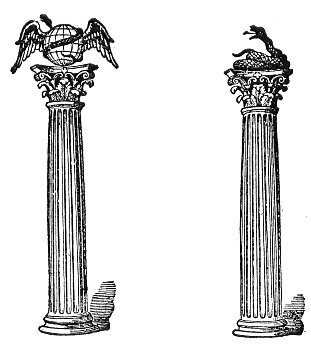p. 490
also, at the Winter Solstice, rose at noon, and at night seemed to be in search of the Sun.
So, referring again to the time when the Sun entered the Autumnal Equinox, there are nine remarkable Stars that come to the meridian nearly at the same time, rising as Libra sets, and so seeming to chase that Constellation. They are Capella and Menkalina in the Charioteer, Aldebarán in Taurus, Bellatrix, Betelgueux, the Three Kings, and Rigel in Orion. Aldebarán passes the meridian first, indicating his right to .his peculiar title of Leader. Nowhere in the heavens are there, near the same meridian, so many splendid Stars. And close behind them, but further South, follows Sirius, the Dog-Star, who showed the nine Elus the way to the murderer’s cave.
Besides the division of the signs into the ascending and descending series (referring to the upward and downward progress of the soul), the latter from Cancer to Capricorn, and the former from Capricorn to Cancer, there was another division of them not less important; that of the six superior and six inferior signs; the former, 2455 years before our era, from Taurus to Scorpio, and 300 years before our era, from Aries to Libra; and the latter, 2455 years B. C. from Scorpio to Taurus, and 300 years B. C. from Libra to Aries; of which we have already spoken, as the two Hemispheres, or Kingdoms of Good and Evil, Light and Darkness; of Ormuzd and Ahriman among the Persians, and Osiris and Typhon among the Egyptians.
With the Persians, the first six Genii, created by Ormuzd, presided over the first six signs, Aries, Taurus, Gemini, Cancer, Leo, and Virgo: and the six evil Genii, or Devs, created by Ahriman, over the six others, Libra, Scorpio, Sagittarius, Capricornus, Aquarius, and Pisces. The soul was fortunate and happy under the Empire of the first six; and began to be sensible of evil, when it passed under the Balance or Libra, the seventh sign. Thus the soul entered the realm of Evil and Darkness when it passed into the Constellations that belong to and succeed the Autumnal Equinox; and it re-entered the realm of Good and Light, when it arrived, returning, at those of the Vernal Equinox. It lost its felicity by means of the Balance, and regained it by means of the Lamb. This is a necessary consequence of the premises; and it is confirmed by the authorities and by emblems still extant.
Sallust the Philosopher, speaking of the Feasts of Rejoicing
p. 491
celebrated at the Vernal Equinox, and those of Mourning, in memory of the rape of Proserpine, at the Autumnal Equinox, says that the former were celebrated, because then is effected, as it were, the return of the soul toward the Gods; that the time when the principle of Light recovered its superiority over that of Darkness, or day over night, was the most favorable one for souls that tend to re-ascend to their Principle; and that when Darkness and the Night again become victors, was most favorable to the descent of souls toward the infernal regions.
For that reason, the old astrologers, as Firmicus states, fixed the locality of the river Styx in the 8th degree of the Balance. And he thinks that by Styx was allegorically meant the earth.
The Emperor Julian gives the same explanation, but more fully developed. He states, as a reason why the august Mysteries of Ceres and Proserpine were celebrated at the Autumnal Equinox, that at that period of the year men feared lest the impious and dark power of the Evil Principle, then commencing to conquer, should do harm to their souls. They were a precaution and means of safety, thought to be necessary at the moment when the God of Light was passing into the opposite or adverse region of the world; while at the Vernal Equinox there was less to be feared, because then that God, present in one portion of the world, recalled souls to Him, he says, and showed Himself to be their Saviour. He had a little before developed that theological idea, of the attractive force which the Sun exercises over souls, drawing them to him and raising them to his luminous sphere. He attributes this effect to him at the feasts of Atys, dead and restored to life, or the feasts of Rejoicing, which at the end of three days succeeded the mourning for that death; and he inquires why those Mysteries were celebrated at the Vernal Equinox. The reason, he says, is evident. As the sun, arriving at the equinoctial point of Spring, drawing nearer to us, increases the length of the days, that period seems most appropriate for those ceremonies. For, besides that there is a great affinity between the substance of Light and the nature of the Gods, the Sun has that occult force of attraction, by which he draws matter toward himself, by means of his warmth, making plants to shoot and grow, etc.; and why can he not, by the same divine and pure action of his rays, attract and draw to him fortunate souls? Then, as light is analogous to the Divine Nature, and favorable to souls. struggling to return to

Moe is the founder of GnosticWarrior.com. He is a father, husband, author, martial arts black belt, and an expert in Gnosticism, the occult, and esotericism.






